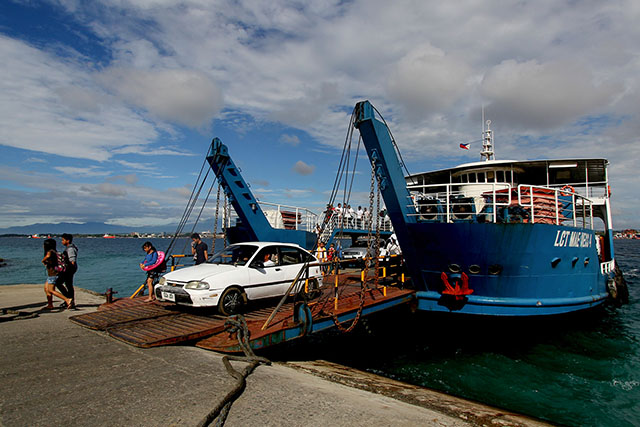DAVAO CITY (MindaNews / 21 May) – The construction of the proposed Davao City-Samal bridge project, which is already recommended for full feasibility study with funding from Asian Development Bank (ADB), will hasten the development of the Island Garden City of Samal (IGACOS) as the prime tourist destination in the Davao Region.
 To get to Samal Island, people have to take the ferry to cross the narrow strait. Mindanews file photo by KEITH BACONGCO
To get to Samal Island, people have to take the ferry to cross the narrow strait. Mindanews file photo by KEITH BACONGCO
In an interview on Monday, Davao del Norte Tourism Officer Noel Daquioag said that the presence of the bridge would lower the cost of construction on the island because it will provide an easier access from the mainland and thus speed up development.
Even though there are willing investors to put up accommodation facilities, Daquioag said they are apprehensive about entering the island due to the high cost in putting up those projects as most of the construction materials would still have to be shipped from the nearby Davao City, most especially black sand used in building roads and other infrastructures.
“The Davao-Samal bridge will hasten up everything. Progress in Samal had been not so fast because of the absence of the bridge because there’s ‘double-handling’ in the construction materials. We have interested investors in the tourism industry but they cannot put up the hotel easily because of the construction materials that they have to transport form Davao City,” he said.
Daquioag said the absence of a bridge makes progress on IGACOS very dismal. The Davao City-Samal route, he noted, is serviced only by four ferryboats that bring vehicles to and from the city.
 Beautiful white beaches abound in the Island Garden City of Samal. MindaNews file photo by FERDINANDH B. CABRERA
Beautiful white beaches abound in the Island Garden City of Samal. MindaNews file photo by FERDINANDH B. CABRERA
Some of the locals agree to the construction of a bridge due to lack of better medical facilities in the island while others don’t support the plan because it might make Samal “not as serene as they have known it to be,” the tourism official said.
“If you ask a Samaleño, why do you need a bridge? The usual answer is, in life and death situations, we need to transport our patient to the city [Davao] for treatment. If you dissect the answer, it’s not really the bridge that she or he needs but a very good tertiary hospital,” Daquioag said.
On the issue of conservation, he maintained that locals would still be able “to retain the beauty of the island” even with the proposed bridge project if they are able to enforce safety nets.
“So it’s really a matter of political will also – somehow, looking at the carrying capacity of the island plus, of course, the peace and order situation and other safety nets that we would like to be implemented in the island,” Daquioag added.
National Economic Development Authority (NEDA) 11 director Maria Lourdes Lim said earlier that a grant worth P90 million from the ADB has been set aside to conduct a full feasibility study on the Davao City-Samal Bridge.
Lim, also vice chairperson of the Regional Development Council (RDC) 11, said that the feasibility study might be undertaken this year although the government has yet to decide on the group who would undertake the study. She said the Department of Public Works and Highways (DPWH) is negotiating with Hong Kong-based consultants.
She said the RDC 11 requested for a budget from DPWH to fund the study but “it was picked up by DPWH as a grant from ADB.”
Lim added the consultants would pick up the previous pre-feasibility study conducted by Japan International Cooperation Agency (JICA) and completed in 2016.
“We want to see initial construction stages happening probably late 2019 or early 2020,” she said.
She estimated the study to be finished in a six to eight-month period.
The “Study on the Project for Construction of Davao-Samal Bridge” conducted by Katahira & Engineers International in 2016 said that “Samal and Davao City, between which there is Pakiputan Strait, are located close to each other.”
“Ferries and boats are the transportation means between Davao City and Samal Island and availability of which are restricted by the operation schedule as well as the weather thus, giving inconvenience to the lives of the people, especially those on the island,” it added.
The study said that the “waiting time for the ferry is too long at peak times because travelers to Samal Island have been rapidly increasing due to the upsurge development of the island because of the numerous beach resorts and high class residential areas.”
Citing JICA’s “The Study on the Davao Integrated Development Program (DIDP) Master Planning March 1999”, it said a bridge connecting the city and the island was recommended because the island has a high potential for high-grade residential development, environmental friendly industrial estate, and cultural and financial centers under the BIMP-EAGA scheme as well as resort development because Samal is so near the city.
It added that realization of the bridge project is urgently needed because of the high development potential of Samal Island, expectation of the rapid progress in development and securing safety for about 100,000 residents in the island and for about 700,000 tourists.
“Considering the state that the number of tourists and travelers who use the ferries are remarkably increasing, economic loss generated by the waiting time for ferry is increasing year by year,” it added. (Antonio L. Colina IV / MindaNews)
